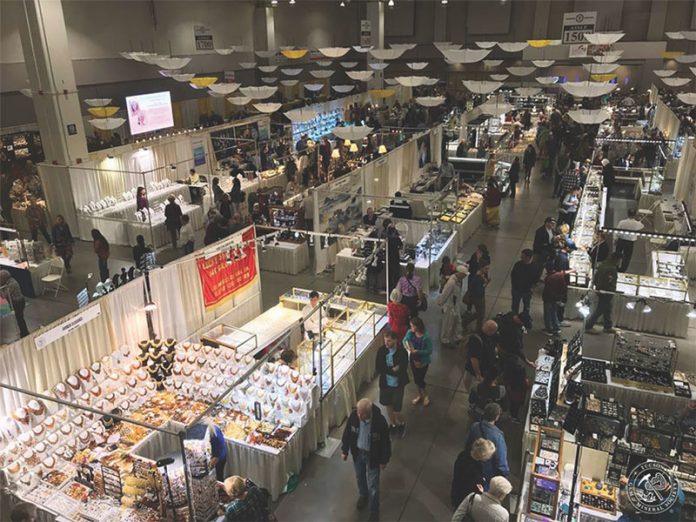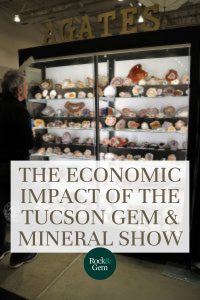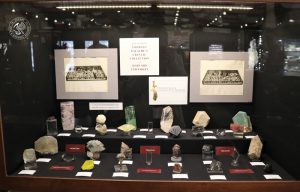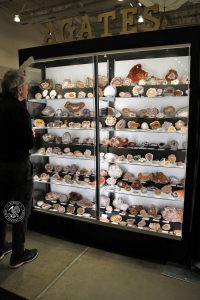
The Tucson Gem & Mineral Show is billed as the largest, oldest and most prestigious gem and mineral show in the world and its economic impact extends beyond the borders of the convention show hall.
“Over the last several years, the public and private sectors have banded together with the common goal of making Tucson a better place culturally and economically,” Steven E. Rosenberg, publisher, and owner of Biz-Tucson said in his 11 Reasons The World is Watching Tucson Summer 2022 issue. “Our downtown is bustling. We are a mecca for tourism.”

With a genesis dating to 1955 and attaining international stature by the 1970s, the Tucson Gem, Mineral & Fossil Showcase at the Tucson Convention Center is, as Christy Krueger cited in 11 Reasons, “THE tourist attraction of our region.” It became and remains a mecca for rock, gem and fossil collectors, drawing more than 65,000 visitors to the region, exhibitors and buyers from more than 40 states and dozens of foreign countries, and resulting in a multi-million dollar impact on the local economy. With so much to see, it’s good to grab some tips for attending the Tucson Gem & Mineral Show before you go.
Now that, as Fred Flintstone might say, adds up to a whole lot of sand dollars.
The Before Times
When tens of thousands of visitors descend annually on a city like Tucson, money flows and when that tide comes in, more than a few boats rise together.
Pre-pandemic economic impact and direct spending studies, conducted by Tucson-based market research firm FMR Associates, showed the 2017 gem show enjoyed a 9% gain over the 2014 gem show and, like an economic set of Russian dolls, the 2014 show’s $120 million in direct spending was a 20% increase from 2007, which generated $100 million and a 56% increase in spending compared to $76 million in 20In 2019, just before the world closed down, David Wichner reported for Tucson. com and the Arizona Daily Star that the economic impact of the most recent gem show had topped – for the very first time –more than $200 million.

Jane Roxbury, director of convention services for Tucson, said the 2019 showcase also featured the most individual shows ever (51), up from 48 the year before.
Among the services the city was offering that Maury Destouet, of Tucson Hotel Associates, praised as key to keeping buyers coming back for more was a modern streetcar line that stopped in front of the Pueblo show and a free Gem Ride shuttle service.
Tucson, he said, was doing an “amazing job of catering to and supporting the downtown gem shows. That made it really easy for people to come.”(2)

Lockdown Lessons
Then things weren’t so easy. In October 2020, KOLD News 13 reported another Arizona tourism staple had been canceled because of COVID-19: there would be no 2021 Tucson Gem and Mineral Showcase.
The effects, Tucson Mayor Regina Romero said at the time were, “Devastating for the City of Tucson as much as for the hotels, small businesses, and restaurants in the area that every year saw an influx of investment because of the gem show.”
These effects included an economic impact study funded by Visit Tucson that revealed $13 million had been collected in local tax revenue.
“There’s no way around it,” said Dan Gibson with Visit Tucson. “It changed the scale of the show. A lot of gem sellers and vendors move here and set up permanent or semi-permanent operations here. It was about trying to keep afloat and active, and give people an experience.”
Working with guidelines drafted by the Pima County Health Department, show owners forged on, limiting the amount of people allowed in open-air booths and hotel rooms.
“It just wasn’t possible to do it the same way,” Gibson said.
The After Times
That was then and this is now, thanks to a community as resilient as its rocks.
In 2022, Tucson welcomed the return of the gem show in all its original glory and then some, coinciding as it did with the Fluorescent Mineral Society’s 50th anniversary. The three-week show returned with 48 distinct locations for shows across the city.
“We had some of the most eye-popping exhibits of fluorescent minerals ever seen anywhere. We encouraged people to come out, enjoy our exhibits, and have a great time,” said Peter Megaw, co-chair of the 2022 show. He had pragmatically predicted crowds would return but at 80% pre-pandemic levels. “International guests and visitors couldn’t come, but we expected to recoup a significant amount of the impact over the course of the show.”
He wasn’t wrong. Hitting the pause button on the show did provide– much like with gemstones – tooling into something better and brighter.
“It’s always good to go back and look at procedures,” says Visit Tucson CEO Felipe Garcia. While GemRide did not operate in 2022, “It was a good time to look at how to become better. It resulted in new features for visitors, including significant renovations to the Tucson Convention Center and a re-energized downtown.”
“As operations began normalizing, all eyes were on Tucson for best practices and modeling,” said Jane Roxbury, director of gem show and convention services for Visit Tucson.
“Imagine the logistics issues that come with putting on the Tucson gem show,” vloggers at SupplyChainToday.com, marveled. “Do you think an event planner for a show such as Tucson would make a good supply chain professional?!”
They’ve certainly proven they know how to chip away at challenges large and small.
The 2023 Tucson Gem, Mineral & Fossil Winter Showcase is January 28-February 12, a Fall Showcase is planned in September (TBA). The largest, oldest and most prestigious gem show in the world is still rock solid.
Just How Much DO Visitors Spend?According to statistics compiled by Vantage West Credit Union, Tucson gem show visitors (54% come from outside Tucson) spend $394 per day. The average amount spent for a full trip is $2,700. International visitors are the biggest spenders and compose 70% of visitors who spend $1000 or more per day. |
This story about the Tucson Gem & Mineral Show’s economic impact appeared in Rock & Gem magazine. Click here to subscribe. Story by L.A. Sokolowski.














